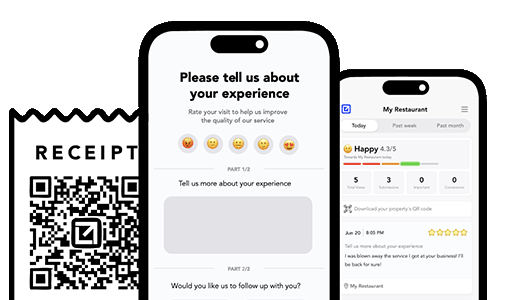Smart Ways to Get More Reviews [Guide]
Practical, proven ways for any business to get more authentic reviews.

TLDR: Most businesses focus on Google reviews, but Apple Maps, used by over 100 million U.S. iPhone users, relies entirely on Yelp. A weak Yelp profile can quietly cost you customers, even if your Google reviews shine. This guide shows how Yelp impacts local search, why its reviews skew negative, and how to improve your profile ethically by collecting private feedback and turning it into public advocacy.
You might think your 4.9-star Google rating is enough. But for iPhone users, over 100 million of them in the U.S., that number doesn’t even show up. When someone searches for a nearby business using Apple Maps, your Yelp rating is what appears first and most prominently. If you’ve ignored Yelp in favor of Google, your online presence might be sending the wrong message, and costing you customers without you realizing it.
Most small businesses spend all their review energy on Google. That makes sense, it’s what powers search rankings, Maps visibility, and SEO. But Apple Maps doesn’t care about Google. It pulls all review data from Yelp. That means if your Yelp profile is old, has only a few reviews, or includes one negative one near the top, you’re losing trust, and traffic.
When someone with an iPhone types “coffee near me” into their device, Apple Maps pulls up results powered by Yelp. The star rating, number of reviews, and even review snippets are pulled directly from Yelp, not Google. That means no matter how strong your Google presence is, iPhone users are seeing a different story.
With over 100 million iPhone users, this matters. And if your Yelp rating is low, or barely exists, it can make your business look untested, unpopular, or untrustworthy, even if you’re none of those things.
It’s easy to dismiss Yelp as old-fashioned or irrelevant. But when Yelp is the public face of your business on Apple Maps, it becomes unavoidable. Businesses that ignore Yelp often suffer from outdated information, negative reviews that go unaddressed, or a complete lack of presence.
Even a few bad reviews can skew your overall star rating. And because Yelp reviews tend to be more detailed and critical, one or two negative experiences can carry outsized weight. Users rarely dig deeper. They just pick the business with the best average rating and move on.
👉 If you’re dealing with a low star rating, our What To Do About Bad Reviews Guide walks you through how to respond effectively, rebuild trust, and turn review setbacks into growth opportunities.
Quantity and quality both matter. If your Yelp page has fewer than 10 reviews, customers may assume you’re new, struggling, or simply not popular. And if one of those is a 1-star review, it disproportionately drags down your reputation.
Even if you’re killing it on Google, a Yelp rating that lags behind tells iPhone users a different story. And in a split-second mobile decision, that can mean they never walk through your door.
The impact is real, one bad Yelp review can cost you thousands in lost business, especially when it’s the first thing Apple Maps users see.
Yelp reviewers tend to be more critical and detailed. It’s a platform built for long-form feedback, and that attracts a certain kind of user. Unfortunately, this also means more emotional, frustrated reviews.
This is part of a larger pattern called negativity bias. Our Why Customers Leave Bad Feedback article explains the psychology behind it and how to reduce the chances of it happening to you.
And here’s the kicker: many of those reviews could’ve been avoided if the business had simply asked for feedback privately. When a customer feels ignored or brushed off, Yelp becomes their outlet. But if they had a chance to share their frustration directly, the situation could’ve been salvaged.
Unlike some other platforms, Yelp frowns on directly asking for reviews. That means no incentives, no mass email blasts, and definitely no fake reviews. But that doesn’t mean you’re powerless.
Create moments in your business where customers can give feedback. QR codes near the register, small “How’d we do?” prompts on receipts, or verbal check-ins go a long way. Use that feedback to identify your happiest customers, and if they mention they had a great experience, gently suggest they leave a review if they feel inclined.
The best way to protect your Yelp reputation is to prevent bad reviews from happening in the first place. Tools like VisibleFeedback let you gather honest, anonymous feedback while the customer is still in your store or shortly after they leave.
If someone has a negative experience, you’ll hear about it first, and have a chance to fix it before they share it with the world. And when someone has a great experience? That’s your opportunity to nudge them toward leaving a public review, where it can actually boost your reputation.
By owning the feedback loop, you can stop the silent churn and build a Yelp presence that reflects the real quality of your business.

Bad reviews can scare away potential customers. Intercept feedback in real time with VisibleFeedback.

Austin Spaeth is the founder of VisibleFeedback, a simple tool that helps brick-and-mortar businesses intercept negative reviews before they go public. With a background in software development and a passion for improving customer experience, Austin built VisibleFeedback to give business owners a frictionless way to collect private feedback and turn unhappy visitors into loyal advocates. When he’s not working on new features or writing about reputation strategy, he’s probably wrangling one of his six kids or sneaking in a beach day.
Whether you have no reviews, bad ones, or great ones, we’ll help you turn your feedback into growth.
No credit card required.
⛨ Trusted by over 137 local businesses like yours